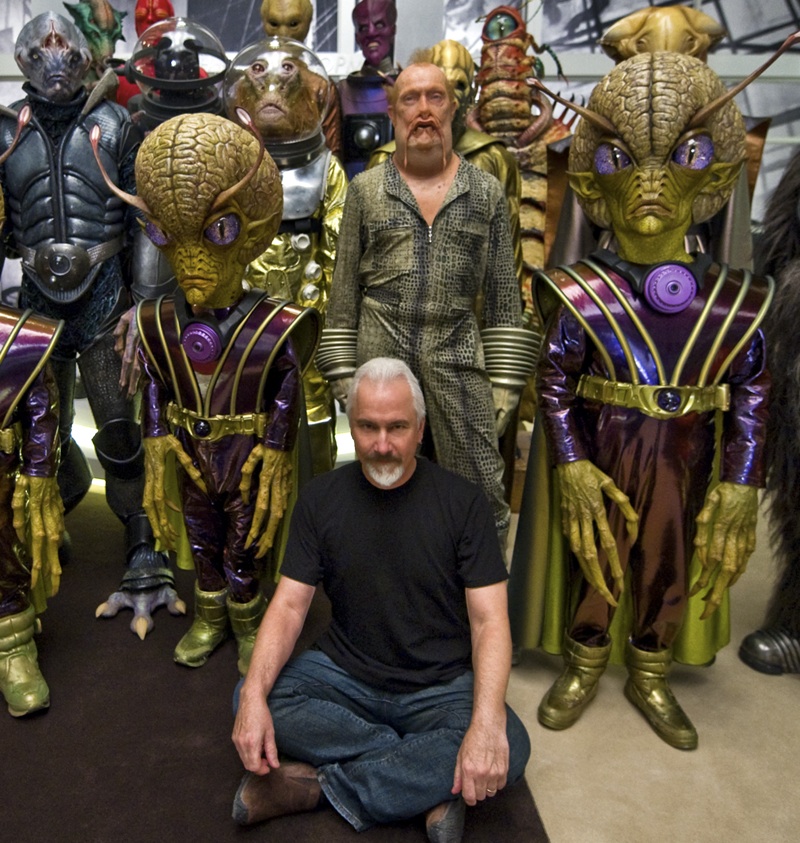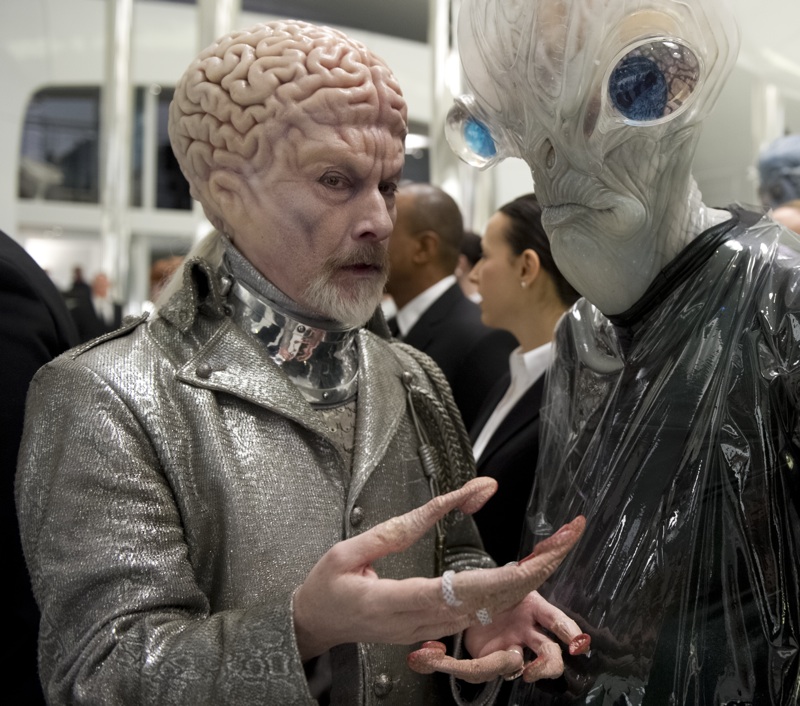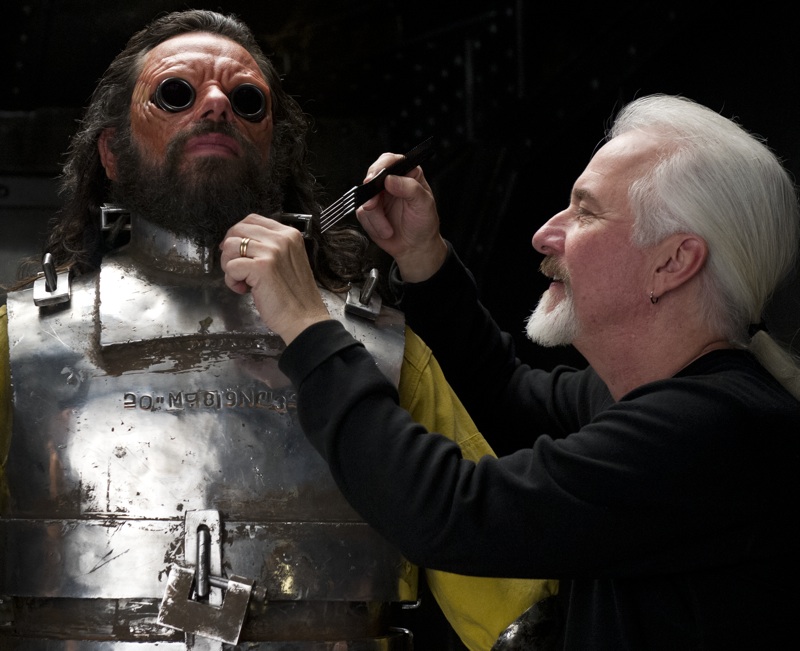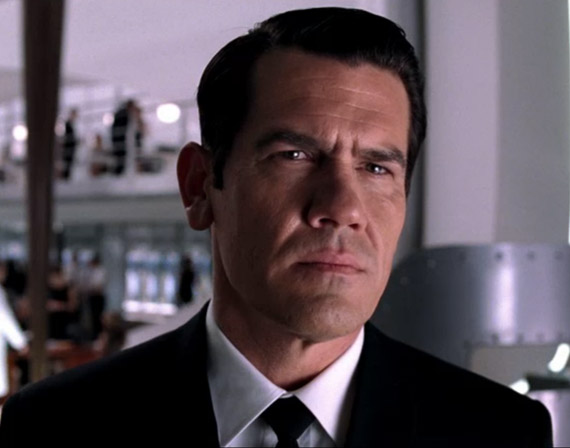 Rick Baker isn’t a recognizable face — mostly because he spends his time behind-the-scenes or on-screen caked with makeup. For thirty years, Baker been stamping the big screen with his signature style of creature makeup and costumes, breaking out with work on 1976’s King Kong remake and the cantina scene in the original Star Wars, and solidifying himself as a major player in films like An American Werewolf in London, The Incredible Shrinking Woman and Videodrome. As the creature scene became more influenced by computer animation, Baker had his feet firmly planted in Hollywood, often called in to design and create for major blockbusters, integrating both practical and digital effects.
Rick Baker isn’t a recognizable face — mostly because he spends his time behind-the-scenes or on-screen caked with makeup. For thirty years, Baker been stamping the big screen with his signature style of creature makeup and costumes, breaking out with work on 1976’s King Kong remake and the cantina scene in the original Star Wars, and solidifying himself as a major player in films like An American Werewolf in London, The Incredible Shrinking Woman and Videodrome. As the creature scene became more influenced by computer animation, Baker had his feet firmly planted in Hollywood, often called in to design and create for major blockbusters, integrating both practical and digital effects.
In the last decade, Baker has worked his magic on How the Grinch Stole Christmas, The Ring, Hellboy, X-Men: The Last Stand, The Wolfman and Robert Downey Jr. in Tropic Thunder. His latest is Men in Black 3, following up his innovative work in the original two movies with a new set of extraterrestrial wonders. Speaking to Hollywood.com at New York’s Museum of Moving Image, which is currently playing host to a number of Baker’s Men in Black 3 designs, the legendary makeup and special effects guru discussed his retro-inspired aliens, his body of work and how things have changed since 1997, when he first worked with Will Smith and director Barry Sonnenfeld on the first Men in Black:
This is your third Men in Black film, and one of many sci-fi movies that has required you to design aliens. When you signed on for this movie, was there any worry of, ‘how am I going to think of something new this time?’
Rick Baker: It is hard to try and top yourself, to do things that people haven’t seen. That’s actually how the whole ’60s, retro thing came about. In the very first Men in Black the first thing they said, ‘we want to see aliens like we’ve never seen before.’ And I said, ‘that’s not going to be easy, because we’ve seen it all.’ I did aliens in the first Star Wars, in the cantina scene, and it was a lot easier then. Ever since the cantina scene, every space movie had a cantina scene with a bunch of aliens in it.
“Let’s get as many aliens in one shot as we possibly can!”
RB: Yeah! So a lot of alien design possibilties have been used. So I said, ‘let’s make aliens like we’ve seen before, but make them better.’ As if the guy who made the aliens in the movies from the ’50s actually saw one. Do the real version. But they didn’t buy it. They didn’t buy it in the second movie either. But in this film with the whole time travel thing, I said, ‘this gives us the perfect reason.’ In 2012 the aliens should look like Men in Black aliens and in 1969 they should be retro aliens. Fishbowl space helmets, guys with space suits with ribbed things on it, exposed brains, bug eyes…well this time they heard it. I always feel like things happen for a reason and it was really meant for this film.
I’ve heard before that Barry isn’t a huge sci-fi guy.
RB: Oh, no. On the first movie, he said in his funny, whiny voice, ‘I’ve never even seen a science fiction movie.’ And I said, ‘Oh God, what have I gotten myself into.’ I tried to have a positive outlook. But I think it worked out to be great because of that. Barry is the person perfect for the Men in Black films. He’s got a really good style, a strong visual sense. But he doesn’t know aliens, he doesn’t want to know aliens.
 Is Will particular about the film’s alien designs? He’s such a major component in getting these movies made.
Is Will particular about the film’s alien designs? He’s such a major component in getting these movies made.
RB: Will was a big part of the whole decision-making process, the course that the whole film took. He really steered it in a certain direction, and a good direction. He chimes in when there’s something he feels strongly about, but he also lets me do my thing. The idea of Boris’ [Jemaine Clement’s character in the film] hand thing, The Weasel, came out of the idea Will had that Boris should have a weapon where he shot quills. In the original script, there was a thing in [the opening scene’s] cake that turned into a gun and I had a big problem with that. How does an organic creature turn into a gun? And the answer was that it was like a Transformer. And I said, ‘no it isn’t!’ Transformers is one machine turning into another machine — it’s not an organic creature turning into a machine.
You laid down some world-building ground rules.
RB: Exactly. And it’s been that way on other movies. On other movies there have been things I don’t think make sense, and there are lots of phone calls with Barry trying to make sense of things. A lot of the times he would say, ‘it doesn’t matter’ — and a lot of times he was right. But what’s great about Barry is that he’ll listen to me, and he doesn’t always agree, but sometimes he’ll say, ‘that’s a good idea.’
Are there movies that drew you into the world of makeup that you were able to pay homage to in Men in Black 3?
RB: Yeah, because they went for it. So I got to make aliens like the ones I grew up with. One is based on a movie called Then Invasion of the Saucer Men that came out in 50’s. Paul Blaisdell built the originals in maybe a week and a half. We spent a lot longer on it. But we paid an homage to the films that I love. I had a blast.
Has new technology enabled you to create new aliens you wouldn’t have been able to make before?
RB: I embrace the new technology. People a lot of times try and pit the rubber guys against the digital guys. To me it’s any trick in your bag of tricks. I’ve always tried to keep current with stuff. I’ve been doing my designs digitally for over 23 years. I started on Photoshop 1.0. I did modeling digitally as well. So the little thing that comes out of [Boris’] hand, I made that model digitally, a 3D model. And then I gave that data to the Sony Imageworks who built it from my digital sculpture. The whole concept of Boris appearance, what he became…I knew Ken Ralston, who was the visual effects supervisor, I’ve known since I was 17 years old. I was so happy he was doing this film. I knew we could do it together.
Were there specific designs or effects where you two collaborated closely on melding physical and digital effects? Maybe with Boris specifically?
RB: Most of the time it’s makeup. The thing I’m surprised I was able to sell them on was the goggles.
No eyes! They’re supposed to be the window for the soul when it comes to acting.
RB: Yeah! When I first did the design and the whole concept for Boris, what he is in the movie changed from the original script. That’s what’s great about the Men in Black movies, Barry sees me as a collaborator. I told him, ‘I think this part needs to be changed.’ And I pitched the whole Boris thing, with these goggles that are shoved into his head. And I knew no one was going to like that because you weren’t going to see the actor’s eyes. I said, ‘yeah, I know, that’s cool!’ They said, ‘we have to see where he’s looking!’ and I said, ‘why?’ It’s scarier and intimidating to not know where he’s looking. It was a battle, but I sunk my heels in and I kept fighting. Thankfully, it happened.
 Did having Jemaine under your makeup help sell it? Did he inform the design?
Did having Jemaine under your makeup help sell it? Did he inform the design?
RB: I came up with the concept for what Boris was going to look like before Jemaine was cast, but when hew as cast I thought, ‘this guy?’ I wasn’t familiar with him! And I thought, ‘his face is so wrong.’ But I told him what I wanted to do, I showed him some stuff. I actually had done a makeup test on myself, so I showed him some video. He was on board with it. I’m a big fan of him now.
How much of your time is spent making yourself up?
RB: A lot. That’s where I learned makeup, using my own face. That’s where my love of it came from. I was able to see the power of actually looking like someone else. I was horribly shy as a kid.
Has that taken a toll on your daughters? That may inform their growing up.
RB: [Laughs] Since the time they were born they’ve been in makeup. Halloween, they didn’t have a choice! But it’s become their hobby.
How much as the way of doing business changed since the first Men in Black, nearly fourteen years ago?
RB: Not that much. Digital technology was around then. Mikey was the alien who was in the Mexican, we had a suit version and had a digital version. The digital stuff has gotten better…we’ve gotten some new materials, that the reality on Edgar I had silicon gel-filled pieces that, now, we use almost exclusively. It hasn’t changed as much as you might think.
Do the challenges evolve alongside the technology?
RB: The first Men in Black was really challenging because we didn’t know what a Men in Black was. It wasn’t until we got three-quarters into the film that we really started to understand. The hardest thing to do on any movie is to get everyone on the same page. There’s so many people involved, it’s such a collaborative medium. That can be a great thing, it can also be a horrible thing. I hate wasting time. Pre-production…the stuff that we make has to be ready on the day. Whatever time I have in advance is my time. When I have three or four or five people who need to make a decision and they’re dragging their feet, and my pre-production time is being compressed, it doesn’t make me happy. It happens on all the Men in Black films — I let people have their input, but at a certain point, it’s, ‘OK, I’m making s**t now.’
 Your work in the Men in Black films is big, vibrant, there, but some of my favorite designs of yours have been the subtle work. Sprucing up characters ever so slightly. Do you have a design that you’re particularly proud of that might be underlooked?
Your work in the Men in Black films is big, vibrant, there, but some of my favorite designs of yours have been the subtle work. Sprucing up characters ever so slightly. Do you have a design that you’re particularly proud of that might be underlooked?
RB: The subtle ones are usually the hardest to pull off, the human kind of things. I don’t think people are going to know…and this isn’t actually my work, but Christien Tinsley did Josh [Brolin’s] makeup on the movie. Christien is Josh’s personal guy, and Barry said he wanted me to do the makeup, but Josh has his own guy. I know Christien very well, and I’d be happy to let him do that, but I’ll consult. I did some Photoshop things very early on and I thought he really needs just a nose and some ears. Josh wanted much more. He wanted cheeks, forehead, all this stuff. I didn’t think it needed that, and it ended up being nose and ears after a few tests. Those kind of makeMaleficentups…most people aren’t going to know. Christien did a flawless job on it. Those makeups are hard to pull off and they go without recognition.
Are there younger people working today that are carrying your torch? Using both practical and digital?
RB: It’s a different time then back in the ’80s when makeup effects took off. I used to get fan mail about every week who wanted to this kind of stuff. There aren’t that many of them anymore. Young kids who would be interested in this kind of stuff are more into the digital aspect of it, and are probably smart to be. I still think a real marriage of the techniques is the way to go. Jack Pierce’s mistake — he did Frankenstein’s Monster and The Wolfman and The Mummy in the ’40s — he was kicked out of Universal for not staying current with what people were doing with makeup. He was doing out-of-the-kit makeup with cotton collodian and spirit gum and other people were doing foam rubber. I took note of that. His stuff saved that studio, but it was gone. I didn’t want that to happen to me. I’m always trying to find the better way. And it’s fun, fun to have a new toy.
That’s probably why you’re still in demand. I know you were recently called in on the upcoming Maleficent [Angelina Jolie’s upcoming fairy tale movie]. Are you recreating the Disney character in that film?
RB: It’s kind of…re-imagining. And I hate that world because we used it on my Planet of the Apes [Tim Burton’s 2001 film]. It’s a film about that character. I was actually in the midst of writing a book about my career that I didn’t want to stop until I got it done. I wasn’t taking film work. But Angelina requested me — she’s kind of hard to turn down. It’s not the traditional Maleficent from the cartoon. But it’s going to be cool.
=”font-style:>
More:
Will Smith Talks ‘Men in Black 3’ — EXCLUSIVE VIDEO
Josh Brolin and Barry Sonnenfeld on ‘MIB3’ — EXCLUSIVE VIDEO
So Long ‘Avengers’: ‘Men in Black 3’ Ready to Take Number One
[Photo Credit: Sony Pictures]



